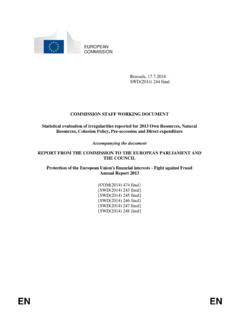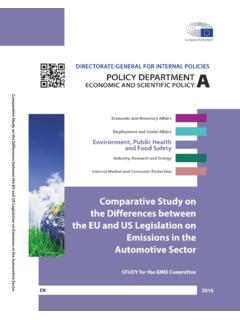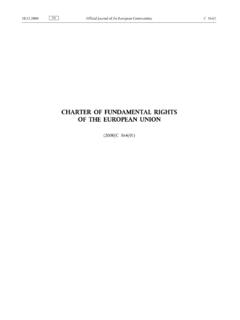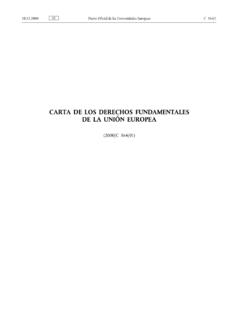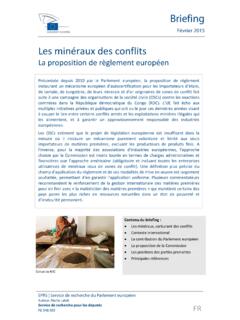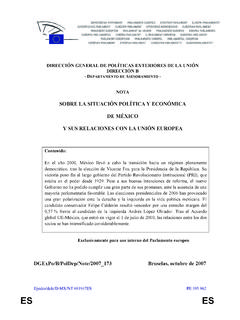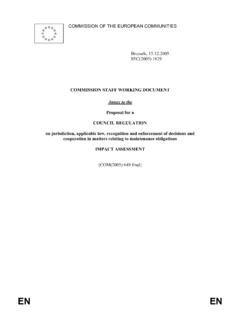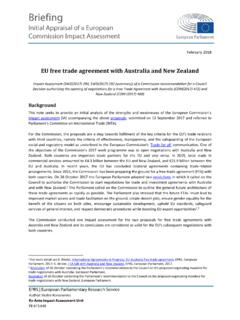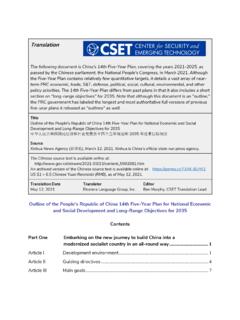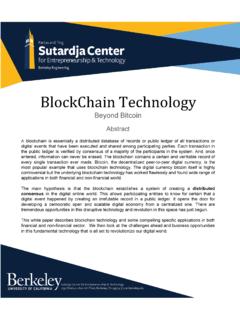Transcription of Cryptocurrencies and blockchain
1 Cryptocurrencies and blockchain Legal context and implications for financial crime, money laundering and tax evasion STUDY Requested by the TAX3 committee Policy Department for Economic, Scientific and Quality of Life Policies Authors: Prof. Dr. Robby HOUBEN, Alexander SNYERS Directorate-General for Internal Policies PE - July 2018 EN Abstract More and more regulators are worrying about criminals who are increasingly using Cryptocurrencies for illegitimate activities like money laundering, terrorist financing and tax evasion.
2 The problem is significant: even though the full scale of misuse of virtual currencies is unknown, its market value has been reported to exceed EUR 7 billion worldwide. This paper prepared by Policy Department A elaborates on this phenomenon from a legal perspective, focusing on the use of Cryptocurrencies for financial crime, money laundering and tax evasion. It contains policy recommendations for future EU standards. Cryptocurrencies and blockchain Legal context and implications for financial crime, money laundering and tax evasion This document was requested by the European Parliament's Special Committee on Financial Crimes, Tax Evasion and Tax Avoidance.
3 AUTHORS Prof. Dr. Robby HOUBEN, University of Antwerp, Research Group Business & Law, Belgium. Alexander SNYERS, University of Antwerp, Research Group Business & Law, Belgium. ADMINISTRATOR RESPONSIBLE Dirk VERBEKEN EDITORIAL ASSISTANT Janetta CUJKOVA LINGUISTIC VERSIONS Original: EN ABOUT THE EDITOR Policy departments provide in-house and external expertise to support EP committees and other parliamentary bodies in shaping legislation and exercising democratic scrutiny over EU internal policies. To contact the Policy Department or to subscribe for updates, please write to: Policy Department for Economic, Scientific and Quality of Life Policies European Parliament B-1047 Brussels Email: Manuscript completed in June 2018 European Union, 2018 This document is available on the internet at: DISCLAIMER AND COPYRIGHT The opinions expressed in this document are the sole responsibility of the authors and do not necessarily represent the official position of the European Parliament.
4 Reproduction and translation for non-commercial purposes are authorised, provided the source is acknowledged and the European Parliament is given prior notice and sent a copy. Cover image used under licence from Cryptocurrencies and blockchain PE 3 CONTENTS LIST OF ABBREVIATIONS 6 LIST OF BOXES 8 LIST OF FIGURES 8 LIST OF TABLES 8 EXECUTIVE SUMMARY 9 GENERAL INFORMATION 11 Background 11 Scope of the research 12 Overview of policy recommendations for future EU standards 14 Cryptocurrencies AND blockchain 15 What is blockchain ? 15 Defining blockchain : a technology with many faces 15 How a blockchain works: the basics 16 The blockchain consensus mechanisms 18 blockchain technology can have many applications 19 What are Cryptocurrencies ?
5 20 Introduction 20 The policy makers: ECB, IMF, BIS, EBA, ESMA, World Bank and FATF 20 Cryptocurrencies Tokens Cryptosecurities 23 Cryptocurrencies blockchain 24 Who are the players involved? 24 Cryptocurrency users 25 Miners 25 Cryptocurrency exchanges 26 Trading platforms 27 Wallet providers 27 Coin inventors 28 Coin offerors 28 CLASSIFYING Cryptocurrencies 29 Scoping the Crypto-Market 29 Bitcoin and beyond: the 10 Cryptocurrencies with the highest market capitalisation 31 Bitcoin (BTC) 31 Ethereum (ETH) 33 IPOL | Policy Department for Economic, Scientific and Quality of Life Policies 4 PE Ripple (XRP) 35 Bitcoin Cash (BCH) 36 Litecoin (LTC) 37 Stellar (XLM) 39 Cardano (ADA) 40 IOTA (MIOTA) 42 NEO (NEO) 43 Monero (XMR) 45 Dash (DASH) 48 Conclusion: a taxonomy and timeline of Cryptocurrencies 49 EU REGULATORY FRAMEWORK 53 Setting the scene.
6 Similar regulatory challenges in the fight against money laundering, terrorist financing and tax evasion via Cryptocurrencies 53 Anonymity 53 Cross-border nature 54 Often no central intermediary 54 Cryptocurrencies are falling between the cracks 54 A difficult dividing line with cybersecurity, data protection and privacy 55 Don t throw the baby out with the bathwater: the technology 56 The tide is changing: AMLD5 57 Money laundering and terrorist financing 58 Background 58 AMLD4 59 Cryptocurrencies under AMLD4 62 The coming of age of the inclusion of Cryptocurrencies into AMLD5 62 Funds Transfer Regulation 68 Cash Control Regulation 69 Tax evasion 70 ADEQUACY OF THE REGULATORY FRAMEWORK 73 Introduction 73 Is the definition of virtual currencies under AMLD5 sufficient?
7 73 Conclusions on the basis of the taxonomy 73 Other virtual currencies than Cryptocurrencies 74 Is it enough to include only custodian wallet providers and virtual currency exchanges in the list of obliged entities? 76 State of play 76 Users 76 Cryptocurrencies and blockchain PE 5 Miners 76 Cryptocurrency exchanges 77 Trading platforms 77 Wallet providers 78 Coin inventors 78 Offerors 78 The initial question 79 Does the AMLD5 framework allow to pull enough cryptocurrency users into the light? 79 Would it make sense to extend the scope of the Funds Transfer Regulation and/or the Cash Control Regulation as to include cryptocurrency transactions?
8 81 Is there a need for a more comprehensive approach, introducing license requirements for Cryptocurrencies ? 81 Is it not best to introduce an outright ban for some aspects linked to some Cryptocurrencies ? 82 Is the European level the appropriate one to tackle money laundering, terrorist financing and tax evasion via cryptocurrency transactions? 83 WHAT ABOUT blockchain ? 85 REFERENCES 86 IPOL | Policy Department for Economic, Scientific and Quality of Life Policies 6 PE LIST OF ABBREVIATIONS AMLD1 First Anti-Money Laundering Directive AMLD2 Second Anti-Money Laundering Directive AMLD3 Third Anti-Money Laundering Directive AMLD4 Fourth Anti-Money Laundering Directive AMLD5 Fifth Anti-Money Laundering Directive BIS Bank for International Settlements CPMI Committee on Payments and Market Infrastructures DAC5 Fifth revision of the Directive on administrative cooperation in taxation DLT Distributed ledger technology EBA European Banking Authority ECB European Central Bank EIOPA European Insurance and
9 Occupational Pensions Authority ESMA European Securities and Markets Authority FATF Financial Action Task Force FIU Financial intelligence unit FTR Funds Transfer Regulation IMF International Monetary Fund ITO Initial Token Offering MTF Multilateral trading facility OTF Organised trading facility P2P Peer to Peer PoS Proof of Stake Cryptocurrencies and blockchain PE 7 PoW Proof of Work PSD2 Second revision of the Directive on Payment Services IPOL | Policy Department for Economic, Scientific and Quality of Life Policies 8 PE LIST OF BOXES Box 1: The Kovri-project 48 Box 2: The PrivateSend mixing-process explained 49 Box 3: Some thoughts on the TITANIUM project 54 LIST OF FIGURES Figure 1: How a blockchain works 17 Figure 2: Coin timeline 52 LIST OF TABLES Table 1: Overview of coins 30 Table 2: Coin taxonomy 51 Cryptocurrencies and blockchain PE 9 EXECUTIVE SUMMARY More and more regulators are worrying about criminals who are increasingly using Cryptocurrencies for illegitimate activities like money laundering, terrorist financing and tax evasion.
10 The problem is significant: even though the full scale of misuse of virtual currencies is unknown, its market value has been reported to exceed EUR 7 billion This research elaborates on this phenomenon, focusing on the use of Cryptocurrencies for financial crime, money laundering and tax evasion. The key issue that needs to be addressed is the anonymity surrounding Cryptocurrencies . This anonymity, varying from complete anonymity to pseudo-anonymity, prevents cryptocurrency transactions from being adequately monitored, allowing shady transactions to occur outside of the regulatory perimeter and criminal organisations to use Cryptocurrencies to obtain easy access to "clean cash".
